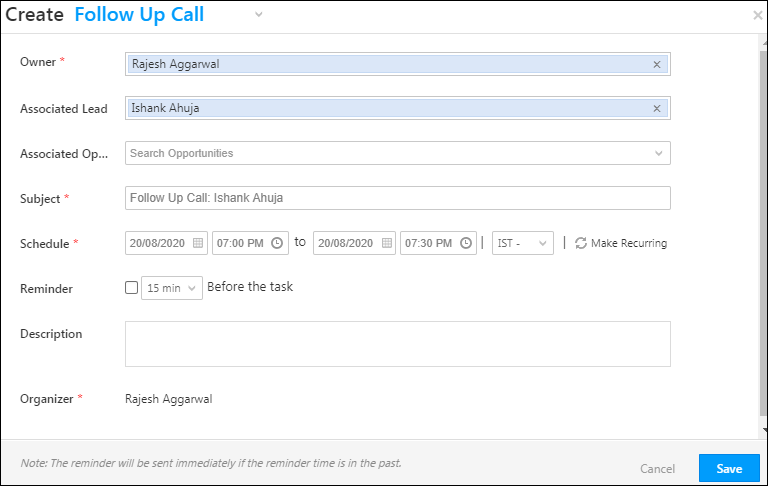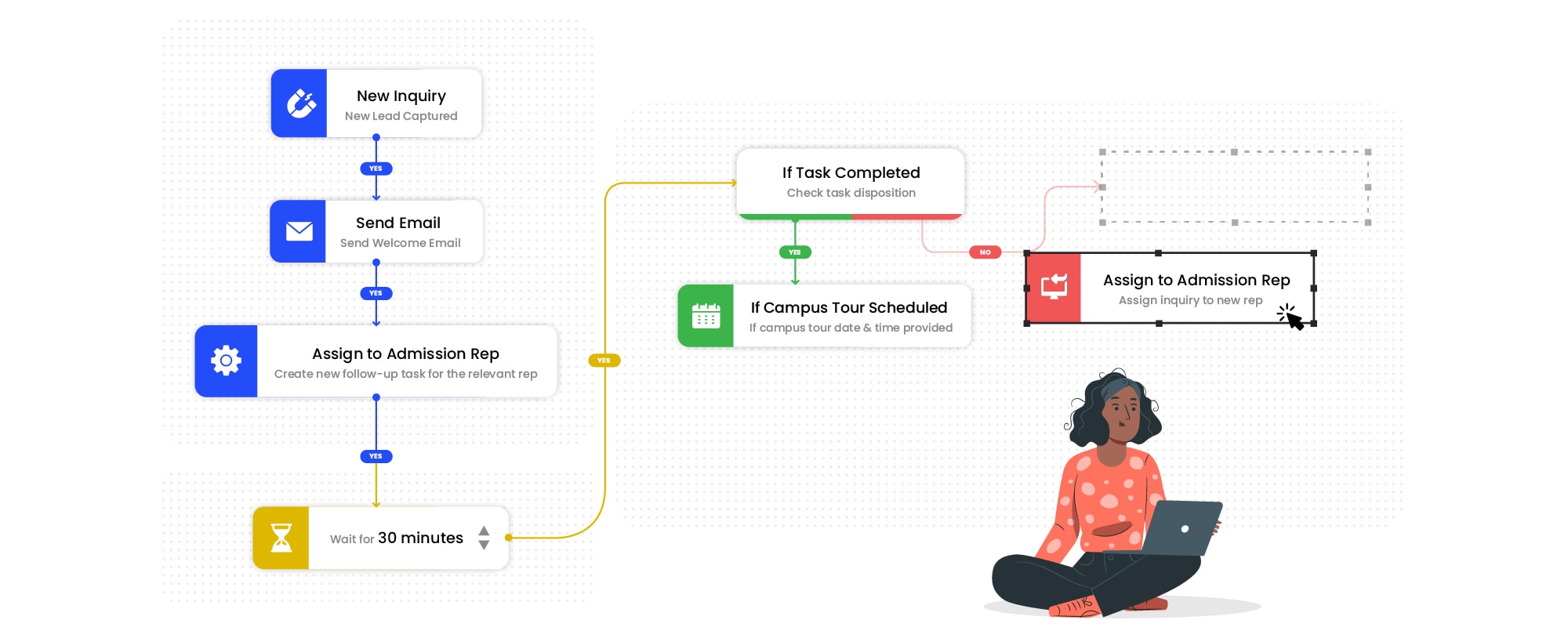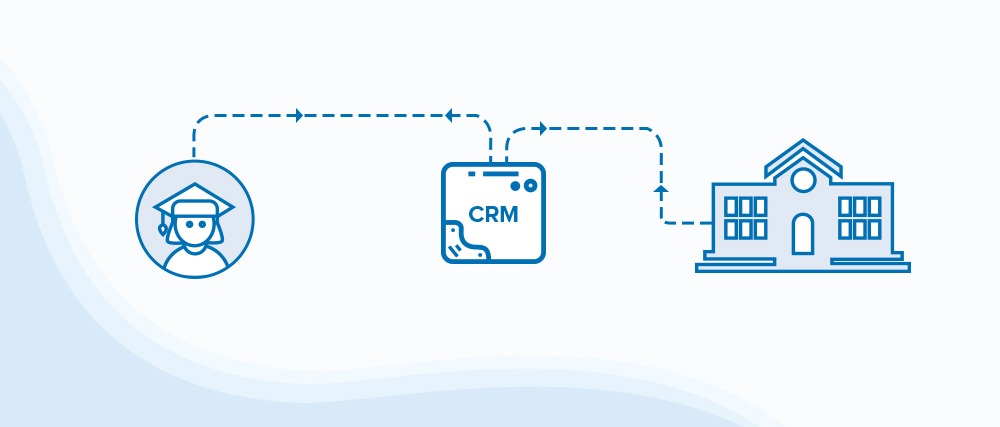Gone are the days when students considered “jobs” their top priority. Now, the trends have changed. Students have become more inclined to pursue higher education instead of taking up a job right after school.
As a result, the demand for quality higher education is at its peak.
But with every institution showcasing its placement records in advertisements, how can you establish your authenticity?
How can you help more students get the quality education that they deserve?
The answer is simple: You must establish an impeccable admission process and understand your student’s expectations.
Your admissions team must contact the prospective students who have raised inquiries as soon as possible and engage them with proper input. A higher education CRM is a must-have asset for automating sales and marketing processes. A CRM for higher education streamlines data management enhances communication and improves decision-making processes. Let me explain why.
CRM in Higher Education – Explained
Customer relationship management software is crucial in managing all your student inquiries. It takes your students through a smooth and streamlined admission process. CRM systems can enhance and automate sales and marketing processes in higher education, facilitating outreach, recruitment, and enrollment by automating follow-ups and managing marketing campaigns more effectively.
An integrated CRM platform serves as a comprehensive tool that enhances understanding and management of various organizational data in educational institutions. It combines information from admissions, student experiences, and marketing, facilitating continuous engagement with students and alumni and allowing for personalized communication that improves student retention.
Institutions can leverage the benefit of such relationships. By utilizing a CRM platform, you can guide prospective students on how your institution can be a torchbearer in their pathway to success and engage them with advisory content throughout their journey in your institution.
Let’s evaluate how CRM serves the Higher Education sector.
Influence of CRM in Higher Education
Customer Relationship Management (CRM) has its roots in the corporate world, where it was initially used to manage customer relationships and boost sales. However, over the past 10-15 years, higher education institutions have increasingly recognized the potential of CRM systems to manage relationships with prospective and current students, alumni, and other stakeholders.
These early systems focused primarily on managing inquiries, applications, and communications with prospective students. As the higher education landscape evolved, so did CRM systems, incorporating advanced features like data analytics, marketing automation, and comprehensive student lifecycle management.
Today, CRM systems are integral to the operations of higher education institutions. They enable institutions to manage relationships with students across the entire student lifecycle, from prospect to alumni. The widespread adoption of CRM systems in higher education is driven by the need to improve student engagement, retention, and success while enhancing operational efficiency and effectiveness.
The Role of CRM in Higher Education Sector
Capturing inquiries efficiently
In today’s digital era, prospective students inquire across various channels, including websites, social media, and PPC ads. Managing these leads can be challenging, especially when inquiry volumes spike around admission deadlines. A CRM system automates lead capture, ensuring all student inquiries are logged accurately, and no potential student is overlooked.
Automated lead capture
CRM systems have lead capture automation that records key details of prospective students—like name, email, phone number, and academic interests—from diverse channels, centralizing information for easy access.
Minimizing lead leakage
By consolidating inquiries, CRM systems ensure no lead goes unnoticed, enabling institutions to make the most of every opportunity.
Efficient inquiry routing
After capturing leads, CRM systems route them to the appropriate admission teams. Managers can then assign inquiries to counselors using methods like round-robin distribution, improving team efficiency and response speed.
Identifying high-potential inquiries
Not all inquiries have equal potential. CRM systems use lead scoring to help institutions concentrate on the most promising prospects, enhancing recruitment outcomes.
Engagement-Based Lead Scoring

CRMs track prospective students’ interactions, such as visiting specific course pages or viewing fee details. Each activity increases the lead score, signaling heightened interest. With lead prioritization, institutions can pursue prospective students who are more likely to join the institution. This saves both money and resources.
Custom scoring criteria
Institutions can define unique scoring criteria, tailoring the CRM system to align with their specific recruitment strategies.
Prioritized follow-ups
With scored leads, admission teams can prioritize high-potential students, ensuring that top prospects receive timely follow-ups, thereby improving conversion rates.
Enhancing student engagement for better retention
Beyond recruitment, CRM systems support student engagement throughout the enrollment and onboarding processes. Institutions can automate follow-ups and reminders, ensuring students feel supported at every stage.
Automated follow-up reminders/calls

CRM platforms send reminders for events like campus visits, document submission deadlines, and registration cutoffs, easing the admissions team’s workload.
Triggered communications
When students reach certain milestones, such as submitting an application, CRM systems send timely emails or notifications with relevant information, enriching the student experience.
Consistent and timely engagement
Automated, prompt communication keeps students engaged and informed, leading to higher retention rates and reduced dropout rates.
Improved data visibility for strategic decision-making
In higher education, timely and informed decisions are vital. CRM systems offer institutions a comprehensive view of student data, equipping decision-makers with insights that drive strategic initiatives.
Centralized data dashboard
CRM systems centralize student information—from demographics to academic performance—into an easily accessible dashboard, allowing informed decision-making.
Trend analysis
By analyzing student behavior, institutions can uncover trends that inform recruitment and retention strategies, enabling targeted outreach and support.
Data-driven interventions
Tracking metrics like attendance and participation enables proactive support interventions, fostering student success and satisfaction.
Streamlining student lifecycle management

Managing the full student lifecycle, from initial inquiry through graduation, is complex. An integrated CRM platform enhances understanding and management of various organizational data, combining information from admissions, student experiences, and marketing. CRM systems simplify this process, allowing institutions to track each student’s journey and provide personalized support.
Recruitment and admissions management
CRMs facilitate lead management, application tracking, and admissions communications, ensuring a seamless recruitment experience.
Continued student support
CRMs track engagement and performance as students progress, providing data for academic advising and career services.
Alumni relations
CRM systems extend beyond graduation, enabling institutions to maintain records for alumni outreach, engagement, and development initiatives.
Supporting student success with targeted interventions
One of the key benefits of CRM in higher education is its role in supporting student success. By tracking engagement and performance, institutions can identify students who may benefit from additional assistance.
Real-time risk alerts
CRM systems can alert advisors when students risk falling behind, allowing proactive outreach and support.
Customized communications
With CRM data, institutions can personalize communications, ensuring students feel recognized and supported.
Boosted retention and graduation rates
By addressing issues early on, CRM systems improve student outcomes, supporting higher retention and graduation rates.
Enhancing alumni engagement and building long-term relationships
CRMs are instrumental in building lasting relationships with alumni, transforming graduates into advocates for the institution.
Alumni engagement programs
CRM platforms help institutions track alumni progress and communicate opportunities for involvement or giving back.
Event notifications and updates
Automated updates inform alumni about networking events, reunions, and institutional achievements, strengthening community bonds.
Career services and continuous support
CRMs connect alumni with career services, further education, and mentorship roles for current students, fostering lifelong connections.
How to Successfully Implement CRM in Higher Education

Implementing a Customer Relationship Management (CRM) system in higher education can transform admissions, boost student engagement, and enhance the overall management of the student lifecycle. With the right approach, CRM implementation can streamline sales and marketing processes by automating follow-ups, managing campaigns, and improving communication for better conversion rates. Here’s a step-by-step guide for successful CRM adoption in higher education, using LeadSquared as a model solution.
Step 1: Define clear objectives and goals
Before beginning the implementation, institutions should define CRM objectives clearly. Consider questions like:
- What challenges do you want the CRM to address? (e.g., lead management, student engagement, data analytics, and sales/marketing automation)
- What outcomes are you aiming for? (e.g., improved enrollment rates, better student retention, or a more streamlined admissions process)
Setting specific, measurable goals like reducing lead response time or boosting enrollment by a certain percentage is essential. LeadSquared CRM offers features specifically tailored for higher education, making aligning the system with these objectives easy.
Step 2: Assemble a cross-functional team
Successful CRM implementation requires collaboration across departments, including admissions, marketing, IT, and academic teams. Form a cross-functional team with representatives from each area to guide the CRM rollout. This team should:
- Identify CRM requirements
- Ensure data security and compliance.
- Test the system for usability and effectiveness, including automating sales and marketing processes
With LeadSquared’s intuitive interface and customizable dashboards, staff across departments can access relevant data and manage interactions effectively. Involving all stakeholders will help ensure that the CRM aligns with each department’s needs and workflows.
Step 3: Organize and clean existing data
A CRM is only as effective as the data it contains. Before importing data, ensure all information is accurate and well-organized. This involves:
- Removing duplicates or outdated records
- Standardizing data formats (e.g., phone numbers, email addresses)
- Segmenting data by criteria like lead source or academic interests
LeadSquared’s automated lead capture will streamline future data entry. The CRM can function efficiently by organizing data from the start, minimizing errors, and enhancing processes like recruitment and enrollment outreach.
Step 4: Integrate CRM with existing systems
Maximize the CRM’s impact by integrating it with other systems, such as Student Information Systems (SIS), Learning Management Systems (LMS), and email platforms. LeadSquared’s integration capabilities ensure seamless data flow, keeping information current and accessible to relevant departments.
Utilizing an integrated CRM platform allows institutions to systematically track each student’s journey from inquiry to graduation, providing a unified view for more personalized engagement. LeadSquared enhances and automates sales and marketing efforts, improving recruitment and enrollment through streamlined communication and campaign management.
Step 5: Customize dashboards and automate workflows
LeadSquared CRM’s customizable dashboards allow departments to monitor metrics relevant to their goals, such as lead response times, engagement rates, and enrollment progress. To optimize workflow, set up automation such as:
- Lead nurturing email campaigns.
- Application deadline reminders
- Follow-up notifications for campus visits
Automated workflows ensure timely, consistent communication, enabling staff to focus on higher-priority tasks while maintaining student engagement.
Step 6: Train staff thoroughly
Comprehensive staff training is essential for CRM success. Provide tailored training sessions for each department, focusing on how they can utilize CRM’s features relevant to their roles. Training topics should include:
- Basic CRM navigation
- Lead capture and management.
- Using automation for follow-ups and communication
- Accessing and interpreting analytics
CRM’s user-friendly interface facilitates use, enabling staff to quickly learn and leverage CRM functionalities. Offering ongoing training or refresher courses will also help new team members get up to speed efficiently.
Step 7: Monitor progress and gather feedback
After launching the CRM, closely monitor progress. Use KPIs to measure the CRM’s impact on enrollment rates, lead response times, and student engagement. Gather feedback from team members to identify strengths and areas for improvement. Monitoring progress can further enhance sales and marketing automation, streamlining communication and boosting higher education conversion rates.
LeadSquared’s analytics and reporting features simplify data collection and performance assessment. Regularly reviewing this data and incorporating feedback will help institutions continuously optimize CRM usage to meet evolving needs.
Step 8: Optimize and scale for long-term success
As familiarity with the CRM grows, look for ways to optimize processes further, such as:
- Implementing new automation based on usage patterns
- Refining lead scoring to better identify high-potential prospects.
- Expanding CRM use to other areas like alumni relations or career services
With its scalable architecture, LeadSquared can grow alongside your institution, supporting expanding enrollment and student engagement goals.
By following these steps and customizing the CRM system to fit your institution’s specific needs, higher education institutions can effectively manage the student lifecycle, improve engagement, and achieve long-term success.
Common Challenges in Implementing CRM in Higher Education
Implementing a CRM system in a higher education institution can be complex and challenging. Some common challenges include:
- Lack of clear goals and objectives: Institutions may struggle to define clear goals and objectives for their CRM system, leading to unclear implementation strategies.
- Insufficient training and support: Adequate training and support for staff and faculty to use the CRM system effectively are crucial for its success.
- Data quality and integrity: Ensuring the quality and integrity of student data is essential for the CRM system’s effective functioning.
- Integration with existing systems: Integrating the CRM system with existing data systems and applications can be challenging and requires careful planning.
Institutions should develop a clear implementation plan to overcome these challenges, provide sufficient training and support, and ensure proper integration with existing data systems and applications. By addressing these challenges proactively, higher education institutions can successfully implement CRM systems and achieve their desired outcomes.
Conclusion
In today’s fast-evolving educational landscape, a CRM system has become essential for institutions that aim to streamline their admissions processes, engage students effectively, and make data-driven decisions. A well-implemented CRM provides admissions teams with powerful tools to manage inquiries, personalize interactions, and automate key tasks, helping them focus on what matters most—building strong relationships with prospective students.
From lead capture automation to mobile access, a thoughtfully chosen CRM can enhance every step of the student journey, improving efficiency and fostering a more seamless, supportive experience for students and staff. With these advantages, a CRM becomes more than just software; it becomes a central part of an institution’s mission to offer quality, responsive education in a competitive environment.
Investing in the right CRM allows higher education institutions to meet today’s demands and stay prepared for tomorrow’s challenges, creating a solid foundation for long-term growth and success.
Are you ready to transform your admissions process into an enrollment accelerator? Click here to
book a free demo!
e









